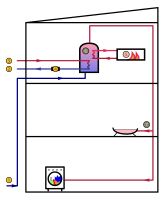
Photo from wikipedia
The hotel sector is characterized by high thermal demands and a large carbon footprint, which greatly contributes to the global warming effect. Consequently, there is a need to investigate solutions… Click to show full abstract
The hotel sector is characterized by high thermal demands and a large carbon footprint, which greatly contributes to the global warming effect. Consequently, there is a need to investigate solutions that can reduce energy usage within this sector by means of environmentally friendly and sustainable technologies. Integrated CO2 heat pump systems for heating, cooling, and hot water production in hotels have demonstrated promising results. This paper theoretically compares the energy consumption, environmental impact, and cost of three different design concepts for integrated CO2 units equipped with thermal storage. The main characteristics of the evaluated designs are single-stage compression, parallel compression, and ejector-supported parallel compression. Furthermore, two separate hot water charging strategies were implemented and investigated over a large span of ambient temperatures and loads. The evaluations were carried out by considering eight different European locations, ranging from Scandinavia to the Mediterranean. The results revealed that the ejector-supported parallel compression design was superior in terms of annual COP, which was found to be in the range of 4.27 to 5.01 for the Scandinavian locations and 5.03 to 5.71 for the other European locations. When accounting for investment cost and electricity prices, the payback period at the Scandinavian locations was 6.3 to 7.7 years. Payback periods of 3 and 4.5 to 7.5 were obtained for hotels located in the temperate and Mediterranean climates, respectively. The investigation also revealed that the hot water charging strategy, rather than the specific CO2 heat pump design, is the least expensive measure to enhance performance.
Journal Title: Energies
Year Published: 2021
Link to full text (if available)
Share on Social Media: Sign Up to like & get
recommendations!